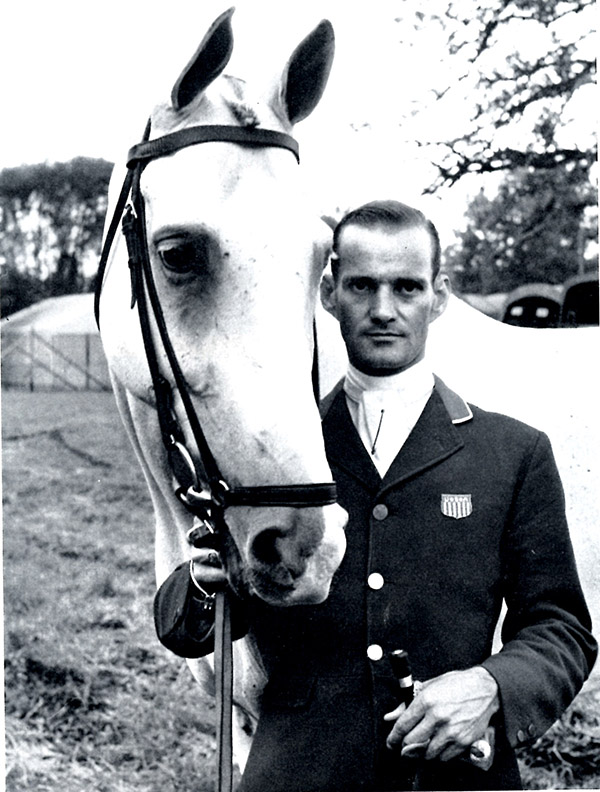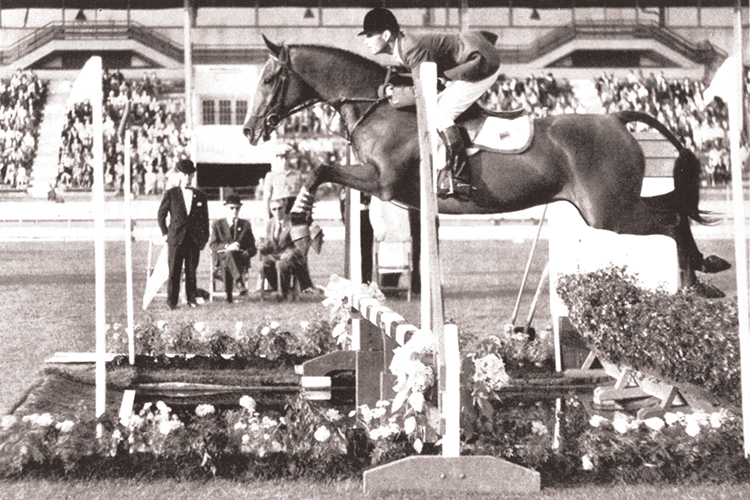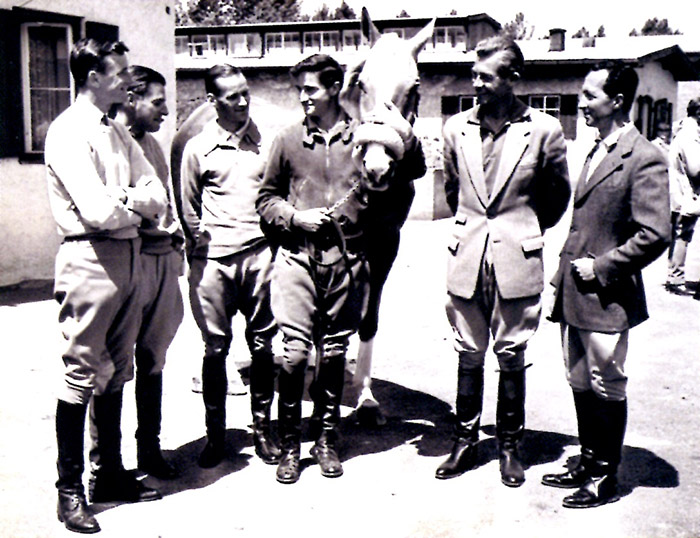
When I met up with George Morris at his Australian Clinic, in early January, I took the opportunity to ask him about one of the greatest riders of all time, William Steinkraus, who had died the previous November, here’s what he told me…
“I grew up in the same County as Bill. I was thirteen years younger. When I first saw Bill, I was a member of the Ox Ridge Hunt club, and he would arrive at 6 am to school Maude Hadden-Farrell’s horses. Maude Hadden’s brother, Briton Hadden founded Time Magazine with Henry Luce. Billy was working in the city at the time. Mrs Farrell had very hot Thoroughbred horses, very difficult, sensitive horses and I would sit in the bleachers and watch. They would set up the Hunter course for the Garden, which is four feet six, it was not like today’s hunters, and he would ride the course. He sat deeper than I was taught. I noticed from the first moment, his gloves, his whip, the horse’s tack, his boots – he wore boot garters – his hat…
“I didn’t know Bill then, but from my first impression he was this meticulous, ultra-sensitive person. The horse he was riding was a very hot Thoroughbred that hung his legs, jumped big but hung his legs and Bill had to hold him off the jumps – and that was always part of Bill’s philosophy, he’d say, ‘make them smile’. And I was always a big ‘releaser’ and that lasted ’til the end of time, I could always get his blood pressure up on the telephone, if I mentioned the crest release. That would make him apoplectic.”
“Later when I started competing on the open jumper circuit, I locked into Bill, Frank Chapot, at the jumper ringside. They were older and I was a young kid, but I started competing against them. The first time I went to Tryon, North Carolina where the WEG was held, was in 1956 where the Olympic Trials for Showjumping were being held for the Melbourne Games, which went to Stockholm – Bill was already way over there, way up there, and I was the kid. The next year, Bert de Nemethy asked me to ride nationally, not on the Team but with Bill and the team members. So we went to national events, about six shows, and there I gradually got to know Bill better.”
“The next three years I was on the team. That was Bert’s first team. Bill Steinkraus was captain, deservedly so, he had a great track record, Bert was chef d’equipe. They were very much one-on-one, Bert and Billy often had disagreements. Billy loved Pelhams because he had very very sensitive hands and he was a Pelham guy, Bert was a fat Snaffle, Hanover school , German fat snaffle guy, but their discussions were interesting. They worked well together, there was no dissension, but the discussions were interesting. Billy was very French School, Bert was a light, Hungarian / Hanover German school. It was a great mix.”

“Billy was an incredible intellect. You can’t say he was a dilettante because whatever subject he brought up, he knew thoroughly: music, literature, language, horses, riding, jumping, shooting, lots of things. If he went to it, he became an expert. He was exceedingly intelligent and meticulous.”
“He and McLain Ward got along well, he loved McLain and McLain loved Billy because they are two peas in a pod. Their boots are shined, their horses are perfectly turned out. I have tapes at home of Billy, meticulous, every detail. He was a sensitive, very kind guy. Tough? Billy was strong and tough, but he was very kind, he was a sweet guy.”
“Billy’s sisters Ruth and Marjorie, I adored, and he adored them, he loved his sisters, I loved them too, they were great girls. Then he married a friend of my sister’s, Helen Ziegler, she’d been a member at Ox Ridge, and I knew her before I knew Billy. She was a wonderful woman, sweet, sensitive, adoring, and he never got over her death. He was obviously tough, he was an Olympic champion and he stuck to his guns but he was very sensitive and kind.”
“They had three children, and after I’d left the team to start as a professional and a teacher, I stayed close to them because I lived in the same vicinity. The boys, Eric, Phillip and Ned started riding, and I was very honored because they sent Phillip to me with a horse or two, and I was very very honored.”
“Then they had a dressage horse, that was not a high level dressage horse, he was a very beautiful not quite Thoroughbred, a German horse that looked Thoroughbred. He moved a ten for a Hunter, so they sent me this horse, Impala, to show as a Hunter. That was a great honor that I had Sis and Bill’s horse to show as a Hunter.”
“For over sixty years our lives intertwined, sometimes closer, sometimes on the telephone. You could not sit with Billy, or talk on the telephone, without it being a learning experience. He said to me, several years ago, I’m still trying to consolidate the French School and the German School, he must have been ninety then! My whole passion – reading, reading, reading – is because I think both schools have a lot to say and I am trying to put them together, which is tricky. He said to me, I’m still trying to figure out how to put the two together. It irritated him that the German school didn’t talk about rein aids. The French talk about rein aids – he said just a couple of months ago, – well they think the hands are just in front of the saddle as decoration. That made Billy crazy because he was fascinated with the rein d’appui, the neck rein, the two indirect reins, he was fascinated with the French school AND the German school, and was steeped in both backgrounds.”
“There won’t ever be another Bill Steinkraus. He not only talked the talk, he walked the walk, Olympic champion, plus, plus, plus. There won’t ever be somebody that wears so many hats: success in the saddle, administration with our Federation, the USET, FEI – there won’t be another Bill Steinkraus, rider, author, Olympic champion, FEI executive. Donna Pillar was the head of the FEI at the time, and I would see her at airports and she would say ‘ how is my Bill?’ She adored Bill Steinkraus.”
“In those days, the people who ran the FEI show – unlike today – would ask the best of the best of that discipline, what should I do? And they would do it. My Federation too – what should I do? Everyone who rubbed shoulders with Bill Steinkraus in an administrative capacity, loved Bill because he was very fair, very knowledgeable about the sport. With people like Max Ammann and the World Cup, Billy would direct them in a very nice way..”.
“There has not ever been a Bill Steinkraus, there will never be another Bill Steinkraus, because he wore so many hats. He played the Viola, he was fascinated with chamber music. Bill was a unique guy.”

The Team – left to right – Hugh Wiley, Frank Chapot, Bill Steinkraus, George with High Noon, Prince Georg von Hannover and Bert de Némethy
Want to know more about Bill Steinkraus and his methods go here
http://www.horsemagazine.com/thm/2010/07/four-showjumping-masters-part-2-william-steinkraus/


There is always a hidden gem in most articles about brilliant riders & trainers, and the one in this for me is Bill Steinkraus talking about rein aids, very helpful, and very timely, I will go back to my books by the masters now, to research this to put into action.
There are always gems in articles about or by brilliant riders or trainers, and the one in this for me is Steinkraus comments on rein aids, how very timely, I will now go back to my books by various masters to refresh my memory on the very important rein aids.